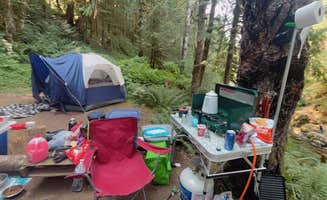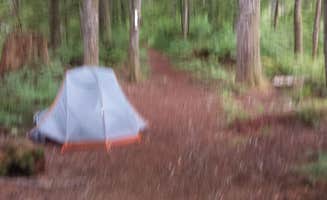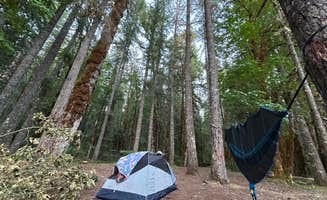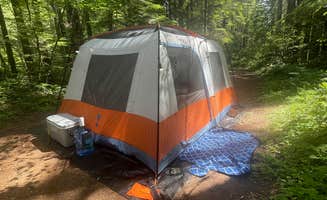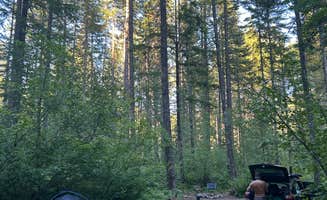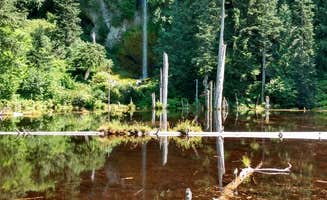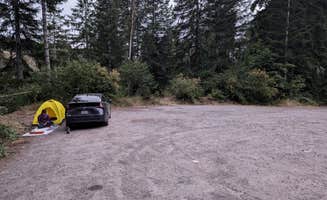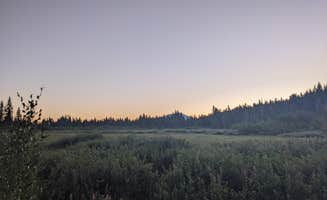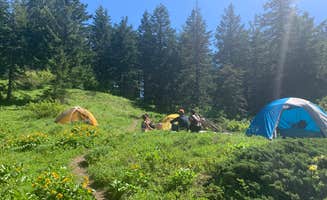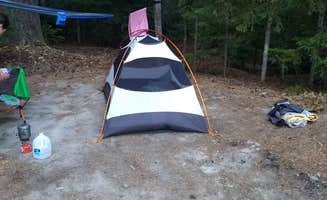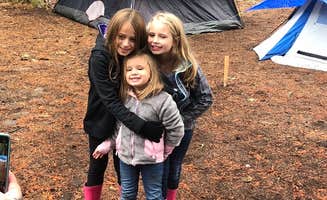Rustic camping near Vancouver, Washington concentrates in Gifford Pinchot National Forest and surrounding areas. These primitive campsites range from 2,500 to 4,500 feet elevation, with mid-May through October offering the most reliable weather conditions. Forest roads throughout the region become snow-covered and impassable during winter months, especially those at higher elevations near Mount St. Helens.
What to do
Creek swimming opportunities: At Little Soda Springs Rd Dispersed, campers can access a short trail leading to the creek. "It's a short hike down to the creek," reports Vanessa T., who adds that the location is "very close to trapper Creek trailhead and there is a vault toilet there."
Stargazing: Tillamook State Forest sites provide excellent night sky viewing opportunities. "Sunrise was one of best I've ever seen, especially with the clouds below," notes Eric R. The higher elevation spots offer particularly clear views with minimal light pollution.
Wildlife viewing: Forest areas around Panther Creek provide opportunities to observe native wildlife in natural habitats. "This was an awesome stay right on the creek which was secluded and nice to hear the rushing water of the creek," shares Bobby J., highlighting the peaceful natural environment.
Waterfall exploration: Short hikes near Beaver Falls Trailhead lead to scenic waterfalls within walking distance of overnight parking areas. "The waterfall is amazing and only a 15 minute hike down!" writes Jaden J., though they caution about "all the trash near the parking lot."
What campers like
Creek-side proximity: Many dispersed sites offer direct access to creeks and streams. At Panther Creek Creekside Camp, campers appreciate the natural water features. "Not too far from the nearest town but you will feel totally immersed out here... Ice cold creek, towering trees," describes Alex R.
Privacy between sites: Most dispersed areas provide adequate separation between campsites. At Canyon Creek in Gifford Pinchot National Forest, Jeffrey P. observed that "'Spaces' were far enough apart that you couldn't even tell anyone else was out there."
Digital detox: The remote nature of these sites limits connectivity. "Absolutely no cell service," warns Vanessa T. about Little Soda Springs Rd. Alex R. confirms at Panther Creek: "My carrier is Verizon, I didn't have any service whatsoever."
Natural noise buffers: Water features provide pleasant white noise that masks sounds from other campers. Jeffrey P. enjoyed Canyon Creek because "you felt like you were deep in it" with the "really relaxing" sound of the river.
What you should know
Road conditions vary: Many forest roads require high clearance vehicles or careful driving. Canyon Creek access can be particularly challenging, with Chris J. noting "road getting in sucks."
Navigation challenges: Forest roads may not align with GPS directions. At Canyon Creek, Vanessa T. warns: "The coordinates here were incorrect coming from Hood River Oregon. It sent me down a rough dead end forest service road. I ended up lost on the mountain for 3 hours."
Variable usage patterns: Weekend traffic increases significantly during summer months. Melissa B. observed at Canyon Creek: "For being such a remote location it was very busy this weekend lots of cars, foot traffic, and fishermen."
Seasonal conditions: Sites at higher elevations become inaccessible during winter months. Autumn B. found that near Mount St. Helens "our original [site] was under 2 feet of snow (late April 2023)."
Tips for camping with families
Safety considerations: Remote areas require extra preparation. At Gee Creek Rest Area I-5, while more developed than most dispersed sites, FeSTeR 1 gave a measured review: "like I said.. could be worse."
Alternative recreation options: The area offers numerous activities beyond camping. Near Mirror Lake, Sonja O. suggests: "If you continue up Tom, Dick, and Harry mountain you can see amazing panoramic views."
Weekend planning: Family groups should prepare for busier conditions during peak periods. At Mount St. Helens Dispersed Camping, Karen notes these areas "do get pretty full on nice weekends. Overall enjoyable camping, just expect neighbors."
Time management: Allow extra travel time on forest roads. The 5-mile access road to Canyon Creek can take 30-45 minutes to navigate safely, particularly with children prone to motion sickness.
Tips from RVers
Site selection: Carefully research road conditions before attempting access with larger vehicles. At Tillamook State Forest, Brendan cautions: "My mistake, these coordinates took us to the top of the mountain... The road up was a very narrow road. So careful if there's other cars coming through, especially the logging semis."
Leveling challenges: Most dispersed sites lack improved surfaces. Jeffrey P. at Canyon Creek suggests: "Would definitely recommend sleeping mats if you're in a tent as the ground's rather hard."
Limited turnaround space: Forest roads often have few opportunities to turn around larger vehicles. Jeremy B. appreciated Beaver Falls Trailhead because it's "a wide dirt pullout with room for 7-10 cars... Plenty of room to turn around with ease."
Overnight options: Consider designated rest areas for quick overnight stays when transitioning between destinations. These provide basic services while maintaining accessibility for larger vehicles.


